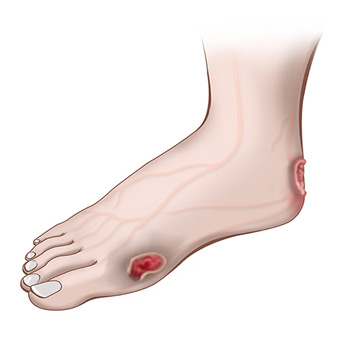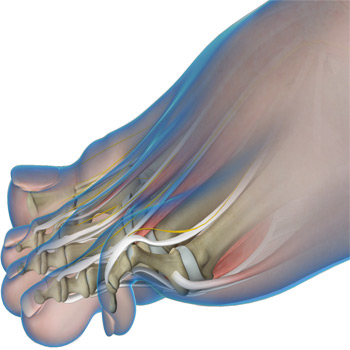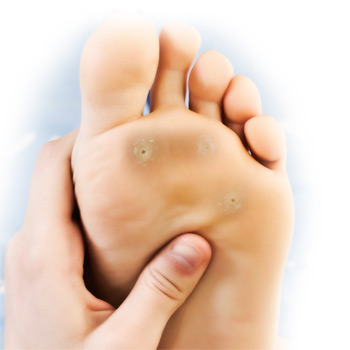- Anatomy
- Conditions
- Procedures
Lisfranc (Midfoot) Injury

The tarsometatarsal joint or Lisfranc joint is the region in the middle of the foot formed by the articulation of the tarsal bones (a cluster of seven bones) and metatarsal bones (a group of five long bones). This region supports the arch of the foot. Lisfranc or midfoot fractures are breaks in the bones of the midfoot. They also involve torn ligaments that support the midfoot. The injury can be simple or complex, involving many bones and joints of the midfoot.
Ankle Sprain

A sprain is the stretching or tearing of ligaments. Ligaments connect adjacent bones and provide stability to a joint. An ankle sprain is a common injury that occurs when you suddenly fall or twist the ankle joint, or when you land your foot in an awkward position after a jump. Most commonly, it occurs when you participate in sports, or jump or run on a surface that is irregular.
Achilles Tendon Rupture

The Achilles tendon is a strong fibrous cord present behind the ankle that connects the calf muscles to the heel bone. It is used when you walk, run and jump. The Achilles tendon ruptures most often in athletes participating in sports that involve running, pivoting and jumping. Recreational sports that may cause Achilles rupture include tennis, football, basketball, and gymnastics.
Plantar Fasciitis

Plantar fasciitis refers to the inflammation of the plantar fascia, a thick band of tissue that is present at the bottom of the foot. It runs from the heel bone to the toes and forms the arch of your foot. Plantar fasciitis is one of the most common causes of heel pain. It is most often seen in middle-aged men and women, but may also occur in those who are constantly on their feet.
Ankle Fractures

Ankle injuries are very common in athletes and individuals performing physical work; often resulting in severe pain and impaired mobility. Pain after ankle injuries can either be from a torn ligament (ankle sprain) or broken bone (ankle fracture). An ankle fracture is a painful condition where there is a break in one or more bones forming the ankle joint.
Ankle Instability

The joints of the ankle are held in place and stabilized by strong bands of tissue called ligaments. Ankle instability is a chronic condition characterized by a recurrent slipping of the outer side of the ankle. It usually results from repeated ankle sprains, which are injuries to the ligaments. Ankle instability is generally noticed when you move your ankle joint but can also occur while standing.
Osteochondral Injuries of the Ankle

The ankle joint is formed by the articulation of the end of the tibia and fibula (shinbones) with the talus (heel bone). Osteochondral injuries, also called osteochondritis dissecans, are injuries to the talus bone. It is characterized by damage to the bone as well as the cartilage covering it. Sometimes, the lower end of the tibia or shinbone may also be affected.
Lisfranc (Midfoot) Fracture

The Lisfranc joint or tarsometatarsal joint refers to the region in the middle of the foot. It is a junction between the tarsal bones (bones in the foot arch) and metatarsal bones (five long bones in the foot). Lisfranc fractures can occur due to a fall from a height or a traumatic motor vehicle accident.
Foot Fracture

Trauma and repeated stress can cause fractures in the foot. Extreme force is required to fracture the bones in the hindfoot. The most common type of foot fracture is a stress fracture that occurs when repeated activities produce small cracks in the bones.
Foot and Ankle Trauma

Foot and ankle trauma refers to injuries that most commonly occur during sports, exercise or any other physical activity. Trauma may be a result of accidents, poor training practices or use of improper gear. Injuries may also be caused when an individual is not medically fit or because of insufficient warm-up and stretching exercises.
Ankle Ligament Injury

An ankle ligament injury, also known as an ankle sprain, can be caused by a sudden twisting movement of the foot during any athletic event or during daily activities. When stretched beyond its limit, the ligament may partially or completely tear. The injury can range from mild to severe, depending on the condition of the injured ligament and the number of ligaments involved.
Foot and Ankle Arthritis

Arthritis is the inflammation of joints as a result of degeneration of the smooth cartilage that lines the ends of bones in a joint. This degeneration of the cartilages leads to painful rubbing of the bones, swelling, and stiffness in the joints, resulting in restricted movements. Arthritis in the foot and ankle can occur due to fractures, dislocation, inflammatory disease, or congenital deformity.
Achilles Tendon Bursitis

Achilles tendon bursitis or retrocalcaneal bursitis is a condition that commonly occurs in athletes. It is a painful condition caused by the swelling of the bursa, a fluid-filled sac that is located at the back of the heel under the Achilles tendon. This retrocalcaneal bursa contains a lubricating fluid that acts as a cushion to reduce friction between muscle and bones.
Ankle Pain

Ankle pain refers to any form of pain or discomfort affecting the ankle joint. Your ankles are more prone to injury and pain since they bear the weight of your entire body.
Foot Pain

The foot is composed of bones, ligaments, tendons, and muscles. As your feet bear the weight of your entire body, they are more prone to injury and pain. Foot pain occurs from distress induced by certain factors on the foot. It is a common problem experienced by young athletes involved in various activities such as running and jumping.
Ankle Dislocation

Ankle dislocation is a condition that occurs when the bones of the lower leg called the fibula and tibia get separated from the talus or ankle bone. This can cause serious damage to the nerves and ligaments surrounding the ankle, leading to a decline in strength and overall health of the leg.
Heel Pain

Heel pain is a common symptom of excessive strain placed on the structures that form the heel. Heel pain can be caused by obesity, abnormal walking style, standing or walking or running on hard surfaces and wearing ill-fitting shoes.
Achilles Tendinitis

Inflammation of the Achilles tendon is known as Achilles tendinitis or tendonitis. The Achilles tendon is a tough band of fibrous tissue that runs down the back of your lower leg and connects your calf muscle to your heel bone. The tendon is used when you walk, climb, jump, run and stand on your tip toes.
Osteochondral Lesions of the Ankle

The tibia and the fibula bones of the lower leg join with the talus bone to form the ankle joint. The talus bone is an important bone located between the tibia and fibula and the heel bone (calcaneus). OCL or OCD is the damage to the cartilage and the talus bone of the ankle joint. Usually, the inner or the medial portion of the ankle is affected.
Heel Spurs

Heel spurs occur when calcium deposits build up on the underside of the heel bone, a condition that develops over time. Heel spurs are caused by stretching of the plantar fascia or foot ligaments and muscle strains.
Ankle Rheumatoid Arthritis

Arthritis is inflammation in a joint as a result of cartilage degeneration causing joint pain, swelling, stiffness, and restricted movement. Arthritis of the foot and ankle joint can occur due to fractures, dislocation, inflammatory disease, or congenital deformity.
Cavus Foot Deformity

Cavus foot also referred to as a high arch, is a condition in which the arch on the bottom of the foot that runs from the toes to the heel is arched more than normal.
Bunionette

Cavus foot also referred to as a high arch, is a condition in which the arch on the bottom of the foot that runs from the toes to the heel is arched more than normal.
Foot and Ankle Osteotomy

Foot and ankle osteotomy is a surgery performed to remove parts of a bone in your foot or ankle that might be causing pain or limiting your mobility. The surgery helps relieve pressure on the foot and ankle caused by the bone deformity or injury.
Midfoot Arthritis

Midfoot arthritis is pain and inflammation of the midfoot. It occurs due to damage of cartilage or tissues around the joints. The damage may occur due to injury, aging or autoimmunity.
Foot Problems

Foot problems can involve any part of the foot. They may involve the skin, tendons, ligament, heels, toes, blood vessels, and joints of the foot.
Hallux Rigiditis

Hallux Rigiditis is a form of degenerative arthritis at the metatarsophalangeal or MTP joint where the base of your big toe attaches to the foot. Arthritis is the inflammation of joints as a result of degeneration of the smooth cartilage that lines the ends of bones in a joint.
Ankle Impingement

The ankle is made up of many bones, muscles, and ligaments that aid in the smooth movement of the foot. Ankle impingement is the painful limitation of movement of the ankle due to an abnormality in the soft tissue or bone. Impingement can occur in the ankle's front (anterior ankle impingement) or back (posterior ankle impingement).
Lesser Toe Deformities

Lesser toes in your foot are those other than the big toes and together stabilize your foot while standing and help in balancing the body. Lesser toes are susceptible to various deformities that can affect their position and cause other complications of the toes.
Nail Bed Injuries

Nail bed injuries such as crush and avulsion injuries commonly occur when the nail bed gets compressed between the hard nail on top and the toe bone below it.
Hallux Limitus

Hallux limitus is a condition characterized by stiffness and decreased movement of the big toe. As the condition progresses, bone spurs and arthritis may develop in the toe joint (metatarsophalangeal joint), eventually leading to complete joint rigidity.
Leg Fracture

A leg fracture is when one of the leg's bones breaks or cracks.Your doctor will review your symptoms and medical history and perform a thorough physical examination to assess range of motion and any damage to the ligaments, blood flow, and stability.
Talus Fractures

The talus is a small bone at the ankle joint that connects the heel bone and the shinbones, enabling up and down movement of the foot. Fractures in the talus bone may occur due to a fall from a great height, motor vehicle accident or sports injury.
Bunion

A bunion, also known as hallux valgus, is a bony protuberance that appears on the outer surface of the big toe when it angles toward the adjacent toe. It is an extra bone and a fluid-filled sac that grows at the base of the big toe.
Athlete's Foot

Athlete's foot, also known as tinea pedis, is a fungal infection that forms on the skin of the foot. It is characterized by itchy, moist, white, scaly lesions between the toes that can spread to the sole of the foot.
Forefoot Pain

The forefoot is the anterior portion of the foot formed by five metatarsals, fourteen phalange bones, and various soft tissues. This complicated structure makes pain in this region more complex to diagnose.
Morton's Neuroma

Morton’s neuroma refers to a nerve injury that occurs between the toes, usually the third and fourth toes. This causes pain and thickening of the nerve tissue.
Flatfoot

Flatfoot, also known as “fallen arches” or Pes planus, is a deformity in children’s feet where the arch that runs along the sole of the foot collapses to the ground or is not formed at all.
Foot Infections

Foot infections may occur after trauma to the foot or loss of tissue because of contamination from foreign material and/or bacteria or fungus. Infections can occur in healthy individuals as well as in those whose health is compromised.
Toenail Conditions

Nails are an extension of the top layer of the skin and are composed of a nail plate (top layer) and nail bed (skin below the nail plate). The nail matrix is the region where your toenail begins to grow. Nails are made of keratin (protein) and help to protect your fingers and toes from injury.
Hammertoe

A hammertoe is a deformity of a lesser toe (second through fifth toes), where the toe is bent upward at the toe’s middle joint, resembling a hammer. The bent portion may rub against the shoe causing pain, irritation and develop corns.
Kohler Disease

Kohler disease is a rare bone disorder in children characterized by pain and swelling along the arch of one or both feet. It is commonly seen between the ages of 5 and 7, with boys 4-5 times more likely to be affected. It is usually a self-limiting condition.
Claw Toe

Claw toe is a deformity where a toe bends and appears like a bird’s claw. The affected toe is bent upward from the joint at the ball of the foot, and downward at the joints in the middle and tip of the toe to curl under the foot. Hard, thick skin called corns may develop under the ball of the foot or on the top of the affected toe, causing pain while walking.
Ischemic Foot

Ischemic foot is a condition where there is inadequate blood supply to the foot due to vascular disease or an obstruction in the arteries. The lack of oxygen and nutrients to the tissues disrupt normal cell function, resulting in severe pain and skin ulcers or sores.
Ingrown toenail

An ingrown toenail is a common and painful condition of the toe. It occurs when the side or corner of the nail grows inwards and penetrates the skin of the toe. Pain is often accompanied by swelling and redness. The big toe is affected most often.
Corns

A corn is a circular area of thickened skin developed because of continuous friction or pressure. They usually develop on the soles of feet or on the top or sides of toes and appear as yellowish dead tissue surrounding an area of tenderness.
Foot Lesions

A foot lesion is an abnormal change in an area of skin on the foot. It may be caused by infection, injury or abnormal growth of tissue. Foot lesions are commonly seen in diabetic patients due to nerve damage and poor circulation.
Mallet Toe

Mallet toe is a deformity where the toe abnormally bends downward, resembling a hammer or mallet. The bones at the tip of the toe are connected by the distal interphalangeal joint (DIP).
Diabetic Foot Conditions

Diabetes is a chronic condition that is characterized by high blood glucose (sugar) levels. Diabetic patients are at high risk for developing chronic wounds, especially in the feet.
Plantar Warts

Warts are harmless outgrowths on the skin caused by human papilloma virus (HPV) infection. They grow on all body parts including face, fingers, feet, legs, hands, knees, inside your mouth, and on the genital and rectal areas.
Deep Vein Thrombosis (DVT)

Deep vein thrombosis (DVT) is a serious medical condition in which a blood clot forms in one or more of your body's deep veins. This condition usually occurs in the lower leg or thigh but can also occur in other veins located deep inside the body.
Stress Fractures of Foot and Ankle

A stress fracture is described as a small crack in the bone which occurs from an overuse injury of a bone. It commonly develops in the weight-bearing bones of the lower leg and foot.
Metatarsalgia

Metatarsalgia is a condition in which pain and inflammation are caused due to overuse or injury to the ball of the foot - the area between the toes and the arch. This condition mainly affects the joints at the base of the five-toe bones.
Toe Fractures

A fracture is defined as a break in the continuity of the bone when a force against your body is too strong for the bone to bear. A toe fracture is when one or more of the toe bones of the foot are broken after severe trauma to the toes or foot.
Pediatric Foot Conditions

Pediatric foot conditions refer to a wide range of foot disorders that may affect the muscles, tendons, and bones of the foot causing significant foot deformity and functional limitations.
Tarsal Tunnel Syndrome

The tarsal tunnel is a narrow passageway that lies on the inside of your ankle and runs into the foot. It encloses arteries, veins, tendons and nerves that supply the foot.
